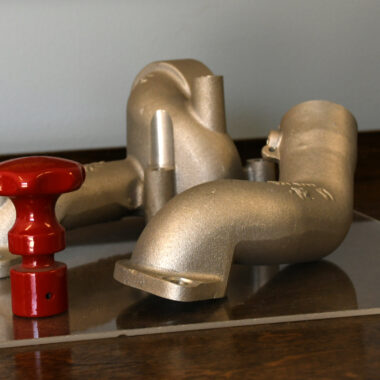Casting Aluminum Mastery: Release Your Imaginative Potential
Wiki Article
Light Weight Aluminum Spreading Solutions Revealed: Necessary Insights and Tips
Exploring the world of light weight aluminum spreading services can introduce a globe of detailed processes and nuanced factors to consider that are important for effective outcomes. As we venture into the world of light weight aluminum casting services, prepare to uncover the crucial components that can shape the trajectory of your jobs and elevate your understanding of this complex craft.The Basics of Aluminum Casting
What essential procedures are associated with light weight aluminum casting that create the foundation of this extensively used manufacturing strategy? Aluminum casting is a cost-efficient and versatile method utilized in different sectors to develop facility and detailed metal elements. The process begins with the melting of aluminum ingots in a heating system, generally at temperatures ranging from 1220 ° F to 1670 ° F, depending upon the certain light weight aluminum alloy being utilized. When molten, the aluminum is poured into a pre-designed mold cavity, where it solidifies and takes the form of the mold and mildew.After solidification, the mold is gotten rid of, and the spreading goes through ending up procedures such as heat surface area, treatment, and machining finish to meet the required specs. Comprehending these fundamental processes is necessary for attaining high-quality aluminum castings with mechanical residential properties and exact dimensions.
Various Casting Techniques Clarified
Discovering the numerous strategies used in aluminum spreading uses useful insights right into the varied techniques used to accomplish precise and detailed metal components. One common method is sand spreading, where a mold is developed making use of compressed sand around a pattern of the preferred part. This strategy is cost-effective and versatile, suitable for both basic and intricate forms. Another approach, die spreading, includes injecting liquified aluminum into a steel mold and mildew under high pressure. Pass away casting enables high accuracy and repeatability, making it ideal for automation of small to medium-sized components. For more detailed styles, financial investment casting is commonly liked. This method utilizes wax patterns that are dissolved, leaving a dental caries for the liquified aluminum to fill up. Financial investment casting yields specific details and smooth surfaces, making it preferred in markets such as aerospace and vehicle. Each spreading technique has its distinct advantages and is chosen based upon aspects such as intricacy, quantity, and price factors to consider.Factors to Take Into Consideration When Picking a Supplier
When picking a light weight aluminum spreading provider, evaluating their experience and competence is critical for ensuring top quality and integrity in the production process. The supplier's experience in the field indicates their familiarity with various spreading methods, potential challenges, and ideal methods. It is crucial to ask about the types of jobs they have actually worked with in the past, ensuring they straighten with the intricacy and requirements of your own job.In addition, take into consideration the service provider's online reputation within the industry. Seek testimonials, testimonies, and study that show their capacity to visit this site provide high-quality aluminum castings regularly. A trusted copyright will frequently have qualifications or associations with sector organizations, showcasing their commitment to quality and adherence to market criteria.
Furthermore, assess the copyright's capabilities in terms of personalization, volume demands, and task timelines. Ensure that they can accommodate your particular needs and have the versatility to range production as needed. Effective communication and openness pertaining to prices, preparation, and high quality control procedures are likewise vital factors to click this link consider when choosing an aluminum casting provider.

Typical Obstacles and Solutions
Navigating via the intricacies of light weight aluminum casting processes frequently provides makers with a series of challenges that require ingenious options to make sure effectiveness and quality in manufacturing. One common difficulty dealt with in aluminum spreading is the formation of flaws such as porosity, shrinking, or inclusions due to inappropriate mold and mildew design or poor metal quality.Implementing sophisticated modern technologies like computer-aided style (CAD) and computer system mathematical control news (CNC) machining can enhance accuracy and consistency in light weight aluminum casting. By investing in automation and real-time tracking systems, makers can boost procedure control and minimize variations, ultimately improving the overall quality of aluminum cast products.
Tips for Optimizing Your Casting Projects
To enhance the efficiency and quality of your aluminum casting projects, applying strategic optimization techniques is vital. One crucial tip for enhancing your casting projects is to thoroughly create eviction system. By ensuring that eviction system is properly designed and effectively positioned, you can improve the flow of liquified light weight aluminum and minimize the possibilities of defects in the final spreading. Furthermore, using computer simulations can aid in predicting and examining the circulation of steel during the casting process, permitting for changes to be made prior to actual manufacturing begins.
Conclusion
To conclude, understanding the basics of aluminum casting, various casting approaches, factors to take into consideration when choosing a copyright, typical obstacles and services, and pointers for optimizing casting jobs are essential for successful results. By sticking to these insights and implementing best individuals, businesses and methods can make certain reliable and effective light weight aluminum spreading solutions that fulfill their specific demands and requirements.Recognizing these basic processes is necessary for accomplishing high-quality light weight aluminum castings with mechanical properties and precise measurements.
When choosing a light weight aluminum spreading solution supplier, evaluating their experience and experience is important for guaranteeing top quality and integrity in the manufacturing process. Reliable communication and openness concerning prices, lead times, and high quality control procedures are additionally critical elements to think about when selecting an aluminum spreading solution copyright.
Navigating with the intricacies of aluminum spreading processes typically provides suppliers with a collection of challenges that call for innovative remedies to make sure performance and top quality in manufacturing. One common obstacle dealt with in aluminum spreading is the development of problems such as porosity, contraction, or additions due to improper mold layout or inadequate steel quality.
Report this wiki page